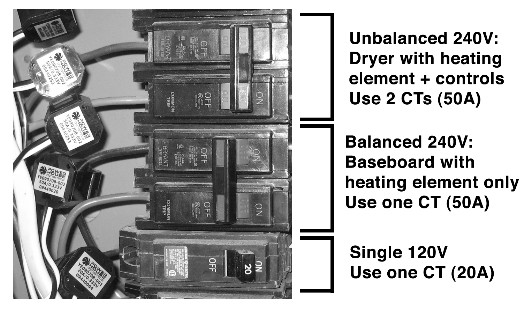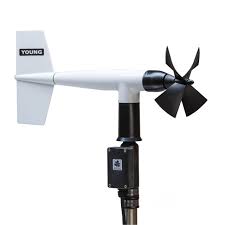Measure Electricity Use with Current Transformers
Sensors,
Meters, and Apps
Current transformers (CTs) are the most accurate way to measure power and energy for buildings, electrical panels, circuits, wind turbines, and solar PV.
Summary
CTs clamp around wires connected to each circuit breaker or the mains. They surround the wire with magnets to create an electric current in proportion with the amount of electricity flowing through the wire. CTs wire back to the electricity meter. In many cases, the app calculates energy based on power readings. However, some electricity meters report cumulative energy over time.
This blog post explores sizing, choosing, and installing CTs. Contact PowerWise if you are interested in purchasing technology to measure electricity use or solar production with CTs.
Choose the Right CT
CTs offer many options. The most important CT criteria include amp rating, dimensions, output, and accuracy.
CTs are sized for the mains or branch circuit in terms of amps. The mains or an electrical electrical circuit will use about 80% or less of its rated capacity. As for CTs, they typically have a range of 5% to 120% of their rated value.
The table below lists circuit / mains sizes and the recommend CT.
| Circuit / Mains Range | Recommended CT |
|---|---|
| 10A-30A | 20A |
| 30A-70A | 50A |
| 70A-225A | 150A |
| 225A-500A | 300A |
| 500A-800A | 600A |
| 800A-1600A | 1000A |
| 1600A-2500A | 2000A |
CT Dimensions, Conductor Size
The CT dimensions / openings are also important, especially for larger buildings. The CT openings need to have enough space to fit around the wire / conductors. A 150A CT with a one-inch CT opening is normally suitable for 200A or 225A service. In larger buildings, however, the conductors may have a larger diameter or may have multiple conductors per phase. Check the CT dimensions and electrical schedules in these instances.
Double Breakers, Triple Breakers
Electrical circuits are typically single pole, double pole, or triple pole. Generally speaking, two CTs should be used on a double breaker and three CTs for a triple breaker. The next section breaks down when a single CT can be used for a double breaker.
Balanced Loads vs. Unbalanced Loads
If a double breaker circuit is “balanced”, power is evenly drawn through both poles. In this instance, an energy monitoring app can typically take the reading from one CT and multiply it by 2 to get the correct power reading.
However, if a circuit is “unbalanced”, two CTs should be used. Pumps, electric resistance heat, and HVAC units are typically balanced. Subpanels, dryers, electric ovens/ranges, and hot tubs are not balanced. Typically, if a piece of equipment is doing more than one thing, it is an unbalanced load. A dryer needs to rotate the drum and dry the clothes. Also, if a circuit has a neutral wire, this most likely means that the load is unbalanced and requires two CTs.
When monitoring 3-phase electricity, always use a CT for each pole.

Extending CT Wires
CT wires are typically 3 feet in length. In some cases, they can be ordered with longer leads. Installers may want longer wires for a variety of reasons. The wiring can be extended using the same gauge wire. Note that cutting the wire invalidates the warranty for the CTs. SiteSage CTs have a unique connector. CT wires can be extended up to 30 feet. PowerWise recommends 22-Gauge twisted pair (2-wire) extension wire for SiteSage CT’s.
CT Accuracy Ratings
Most CTs have a +/- 1% accuracy rating. For billing purposes or revenue-grade metering, the CTs and the electricity meter are of higher accuracy and need to be revenue-grade. PowerWise recommends and uses the Dent Electricity meter and the appropriate CTs for these applications.
Installing CTs
Many CTs have arrows on them. In general, install the CTs so that the arrows point to the load, unless otherwise instructed by the manufacturer. With SiteSage 150A CTs, there are no arrows. So, the label plays the role of the arrow. Place them with the label toward the load.
When using WattNode or Dent Electricity meters, CTs need to be on the correct phase. Refer to the manufacturer’s installation manuals for complete instruction. Not paying attention to phases when installing CTs will generate unusable data from the electricity meter.
Questions about CTs and Measuring Electricity Use?
Please contact PowerWise at +1-207-370-6517 or email sales@powerwisesystems.com if you have any questions.
Featured Solution
Easily monitor any number of circuits with SiteSage. The platform is plug-and-play and has been commercially available for 10 years.
Recent Posts
All Blog Posts >>
About PowerWise
PowerWise is a proven innovator of monitoring and control technology.
